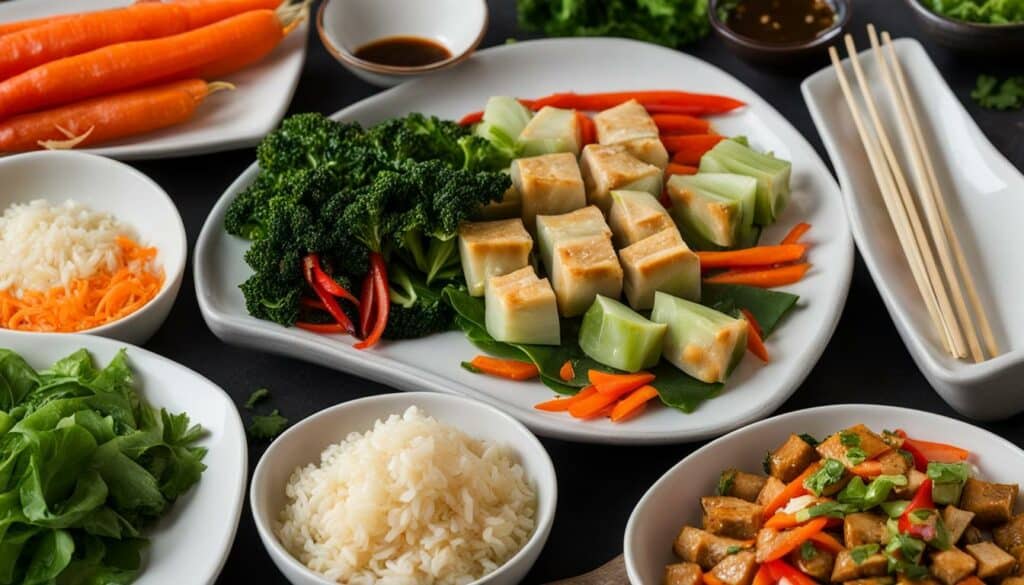Are you a fan of fried spring rolls? These popular Chinese appetizers are made of a thin dough filled with vegetables and deep-fried to perfection. But have you ever wondered about their nutritional information? In this article, we will break down the calorie content and other nutritional facts of fried spring rolls.
Key Takeaways:
- Fried spring rolls can contain anywhere from 80 to 153 calories.
- They typically have 3.5 to 4 grams of fat and 8.5 to 13 grams of carbohydrates.
- Protein content in fried spring rolls is relatively low, with each roll containing only 2 grams.
- The sodium content can range from 135 to 290 milligrams.
- For a healthier option, consider making homemade spring rolls with whole wheat wrappers and filling them with nutrient-rich ingredients.
Calories in Fried Spring Rolls
When it comes to fried spring rolls, it’s important to be conscious of their calorie content, especially if you’re looking for low-calorie appetizer options. The number of calories in a fried spring roll can vary depending on the size and ingredients used. On average, a spring roll contains 80 to 110 calories, making it a relatively light snack compared to other fried foods.
If you’re watching your calorie intake, it’s essential to be mindful of the portion size and the number of spring rolls you consume. It’s easy to indulge in multiple rolls without realizing the cumulative calorie count. To enjoy fried spring rolls as a part of a low-calorie meal, consider pairing them with a side of fresh salad or steamed vegetables to increase the nutritional value while keeping the overall calorie intake in check.
Table: Calorie Comparison of Fried Spring Rolls
| Type of Spring Roll | Calories per Roll |
|---|---|
| Vegetable Spring Roll | 80-90 |
| Chicken Spring Roll | 100-110 |
| Shrimp Spring Roll | 90-100 |
As seen in the table, vegetable spring rolls tend to have the lowest calorie count, making them a great choice for those looking for a lighter option. However, it’s important to note that these values are approximate and can vary depending on the specific recipe and method of preparation.
When enjoying fried spring rolls, remember to savor every bite and eat mindfully. By practicing portion control and balancing your meal with other nutritious foods, you can still indulge in this popular appetizer without compromising your dietary goals.
Fat Content in Fried Spring Rolls
Fried spring rolls typically contain 3.5 to 4 grams of total fat and 0.5 to 1.0 grams of saturated fat. It’s important to note that high intakes of fat and saturated fat can increase the risk of high cholesterol and heart disease. The American Heart Association recommends limiting daily fat intake to 25 to 35 percent of calories and saturated fat to less than 7 percent of calories. If you’re watching your fat intake, choosing low-fat spring rolls or opting for other healthier snack options may be a better choice.
When it comes to fried foods, it’s no secret that they tend to be higher in fat content due to the cooking method. Fried spring rolls are no exception, as the deep-frying process adds additional fat to the already existing fat content present in the roll’s filling. This can contribute to a higher calorie count and potential health risks associated with excessive fat intake.
To make healthier choices when it comes to spring rolls, you can opt for low-fat versions that are available in some restaurants or grocery stores. These spring rolls are typically made with lighter fillings and are either baked or air-fried instead of deep-fried. By choosing these options, you can still enjoy the flavors of spring rolls while reducing your fat intake.
Benefits of Choosing Low-Fat Spring Rolls:
- Lower calorie count
- Reduced saturated fat intake
- Potentially lower risk of high cholesterol and heart disease
While low-fat spring rolls can be a healthier alternative, it’s important to remember that moderation is key. Even low-fat options can still contribute to a high calorie intake if consumed in excess. Additionally, incorporating a variety of other healthy snack options into your diet is a great way to maintain balanced nutrition and keep your calorie and fat intake in check. Choosing fresh fruits, vegetables, and lean protein sources can provide nutrients without the added fat and calories.
| Nutrient | Amount per Fried Spring Roll |
|---|---|
| Total Fat | 3.5 to 4 grams |
| Saturated Fat | 0.5 to 1.0 grams |
It’s important to be mindful of the fat content in fried spring rolls and consider healthier alternatives if you’re watching your fat intake. Making informed choices can help support a balanced diet and overall well-being.
Carbohydrate Content in Fried Spring Rolls
The carbohydrate content in fried spring rolls can vary between 8.5 to 13 grams. Carbohydrates are an essential macronutrient that provides your body with energy. However, it’s important to consider your overall carbohydrate intake and choose healthier alternatives if you’re following a low-carb diet or watching your carb consumption.
When enjoying fried spring rolls, keep in mind that the filling consists of vegetables and a small amount of noodles or rice. These ingredients contribute to the carbohydrate content. To reduce the carb content, you can opt for smaller spring rolls or choose low-carb fillings like shredded lettuce, cucumber, and sprouts instead of noodles or rice.
If you’re looking for low-calorie Asian cuisine, you may consider other options such as fresh summer rolls. These rolls typically use rice paper wrappers filled with a variety of raw vegetables, herbs, and sometimes cooked shrimp or tofu. They are lighter in calories and carbohydrates compared to fried spring rolls while still offering delicious flavors and textures.
The Nutritional Comparison between Fried Spring Rolls and Fresh Summer Rolls:
| Fried Spring Rolls (Per Roll) | Fresh Summer Rolls (Per Roll) | |
|---|---|---|
| Calories | 80-153 | 50-90 |
| Carbohydrates (g) | 8.5-13 | 5-10 |
| Fat (g) | 3.5-4 | 0-1.5 |
| Protein (g) | 2 | 3-5 |
| Sodium (mg) | 135-290 | 100-250 |
As you can see from the table above, fresh summer rolls are generally lower in calories, carbohydrates, fat, and sodium compared to fried spring rolls. They also offer slightly higher protein content. Incorporating fresh summer rolls into your Asian cuisine repertoire can provide a lighter and healthier alternative to fried spring rolls, especially if you’re looking to reduce carb intake or calories.
Protein Content in Fried Spring Rolls
When it comes to fried spring rolls, it’s important to consider their nutritional value, including the protein content. While fried spring rolls may be a delicious snack, they are not a significant source of protein. Each roll typically contains only 2 grams of protein. However, it’s important to note that protein is an essential macronutrient that plays a crucial role in various bodily functions, such as building and repairing tissues, supporting immune function, and promoting satiety.
If you’re looking for healthy deep-fried snacks that offer a higher protein content, there are alternative options to consider. For example, using lean proteins like grilled chicken or tofu as fillings can increase the protein content of spring rolls. Additionally, incorporating other protein-rich ingredients such as shrimp or beans can further enhance the nutritional value of your spring rolls.
It’s also worth noting that you don’t have to rely solely on fried spring rolls to meet your daily protein needs. A balanced diet should include a variety of protein sources, such as lean meats, fish, dairy products, legumes, and nuts. By incorporating a range of protein-rich foods into your meals and snacks, you can ensure you’re getting an adequate amount of this essential nutrient.
| Protein Content | Fried Spring Rolls | Alternative Protein Source |
|---|---|---|
| Grams of Protein | 2 grams | Variety of options, depending on choice of fillings |
In summary, while fried spring rolls may not be a significant source of protein, there are ways to increase their protein content by choosing protein-rich fillings. However, it’s essential to incorporate a variety of protein sources into your diet to meet your daily protein needs. By doing so, you can enjoy a range of healthy deep-fried snacks while ensuring you’re providing your body with the nutrients it requires.
Sodium Content in Fried Spring Rolls

Fried spring rolls, while delicious, can have varying levels of sodium content. Sodium is an essential mineral needed for various bodily functions, but consuming too much can be detrimental to our health. Let’s take a closer look at the sodium content in fried spring rolls and its implications on our overall well-being.
The sodium content in a fried spring roll can range from 135 to 290 milligrams. This amount may seem relatively small, but it’s important to consider it in the context of our overall daily sodium intake. High sodium intake is associated with an increased risk of high blood pressure and heart disease, so it’s essential to limit our consumption.
The American Heart Association recommends keeping our daily sodium intake below 2,300 milligrams, ideally below 1,500 milligrams, to reduce the risk of heart disease. Consuming fried spring rolls occasionally is unlikely to have a significant impact, but if you’re watching your sodium intake or have health concerns, it’s crucial to be mindful of the sodium content in fried foods, including spring rolls.
Healthier Alternatives with Lower Sodium
If you’re looking for alternatives with lower sodium content, consider making your own spring rolls at home. Opt for whole wheat wrappers and fill them with fresh vegetables and lean proteins. Baking or air frying the spring rolls instead of deep-frying can further reduce the sodium content while still providing a delicious and satisfying snack.
Additionally, exploring other low-sodium Asian-inspired dishes can be a great way to enjoy flavorful meals without compromising on taste or health. Look for dishes that incorporate steamed vegetables, lean proteins, and light sauces. By choosing these alternatives, you can still enjoy the flavors you love while keeping your sodium intake in check.
| Food Item | Sodium Content (mg) |
|---|---|
| Fried Spring Rolls | 135-290 |
| Homemade Baked Spring Rolls | Less than 100 |
| Steamed Vegetables with Soy Sauce | Less than 50 |
Healthier Alternatives to Fried Spring Rolls

If you’re looking for healthier alternatives to fried spring rolls, there are a few options to consider. You can try making your own spring rolls using healthier ingredients, such as whole wheat wrappers and filling them with nutrient-rich vegetables and lean proteins like grilled chicken or tofu. Baking or air frying the spring rolls can also help reduce the amount of fat and calories compared to deep-frying. Additionally, you can explore other low-calorie Asian cuisine options that offer a flavorful and nutritious alternative.
Homemade Spring Rolls Recipe
If you’re interested in making your own spring rolls, here’s a simple and healthy recipe to try:
- Prepare the filling by chopping a variety of colorful vegetables like carrots, bell peppers, and cabbage.
- Sauté the vegetables in a small amount of olive oil or sesame oil for a few minutes until they become tender.
- Add cooked and shredded chicken or tofu to the vegetables for added protein.
- Soak the rice paper wrappers in warm water until they become soft and pliable.
- Place a spoonful of the vegetable and protein filling onto the center of each wrapper.
- Roll the wrappers tightly, tucking the sides in as you go.
- Bake the spring rolls in the oven at 400°F (200°C) for about 10-15 minutes or until they turn golden brown and crispy.
- Serve the homemade spring rolls with a dipping sauce made from low-sodium soy sauce, lime juice, and a dash of honey or stevia.
By making your own spring rolls, you have control over the ingredients and cooking methods, allowing you to create a healthier version of this popular appetizer.
Exploring Low-Fat Asian Cuisine
Another option to consider for low-fat Asian cuisine is to explore other dishes that offer similar flavors and textures to fried spring rolls. Some alternatives to try include:
- Steamed dumplings filled with vegetables and lean proteins
- Stir-fried vegetables with tofu or lean meat
- Vegetable sushi rolls
- Grilled skewers with marinated chicken or shrimp
These alternatives can provide you with the flavors and variety you crave while keeping your calorie and fat intake in check.
Conclusion
When it comes to fried spring rolls, it’s important to be mindful of their calorie, fat, carbohydrate, protein, and sodium content. While they can be a tasty indulgence, moderation is key, especially if you’re watching your weight or have specific dietary considerations.
To make healthier choices, consider exploring alternatives to traditional fried spring rolls. By making your own spring rolls using whole wheat wrappers and filling them with nutrient-rich vegetables and lean proteins like grilled chicken or tofu, you can reduce the amount of fat and calories compared to deep-frying.
Baking or air frying the spring rolls is another option to cut down on the calorie count of your favorite snack. These cooking methods help retain the crunch while reducing the overall fat content. Additionally, you can also explore other low-calorie Asian cuisine options that offer a flavorful and nutritious alternative to deep-fried snacks.
Remember, achieving a balanced diet is all about making informed choices. By being aware of the nutritional content of fried spring rolls and considering healthier alternatives, you can enjoy your favorite snacks while maintaining a healthy lifestyle.
FAQ
What are the nutritional facts for a spring roll?
A spring roll typically contains 80 to 153 calories, 3.5 to 4 grams of fat, 8.5 to 13 grams of carbohydrates, 2 grams of protein, and 135 to 290 milligrams of sodium.
How many calories are in a fried spring roll?
On average, a fried spring roll contains 80 to 110 calories. However, a vegetable-filled egg roll can have about 153 calories.
Should I be concerned about the fat content in fried spring rolls?
Fried spring rolls typically contain 3.5 to 4 grams of total fat and 0.5 to 1.0 grams of saturated fat. It’s important to be mindful of your fat intake, as high amounts can increase the risk of high cholesterol and heart disease.
How many carbohydrates are in a fried spring roll?
A fried spring roll can have 8.5 to 13 grams of carbohydrates. While carbohydrates are important for energy, if you’re watching your carbohydrate intake, you may want to limit your consumption of fried spring rolls or choose healthier alternatives.
Are fried spring rolls a good source of protein?
No, fried spring rolls are not a significant source of protein, with each roll containing only 2 grams. It’s important to meet your daily protein needs through other sources in a balanced diet.
Is there a high sodium content in fried spring rolls?
The sodium content in a fried spring roll can range from 135 to 290 milligrams. High intakes of sodium can increase the risk of high blood pressure, so it’s important to be mindful of your sodium intake and consider healthier snack options.
Are there healthier alternatives to fried spring rolls?
Yes, there are healthier alternatives to fried spring rolls. You can try making your own spring rolls using whole wheat wrappers and filling them with nutrient-rich vegetables and lean proteins. Baking or air frying the spring rolls can also help reduce the amount of fat and calories compared to deep-frying.
How should I approach fried spring rolls in a balanced diet?
Fried spring rolls should be enjoyed in moderation, especially if you’re watching your weight or have specific dietary considerations. Exploring healthier alternatives and making homemade versions can help you satisfy your cravings while making more informed snack choices.







